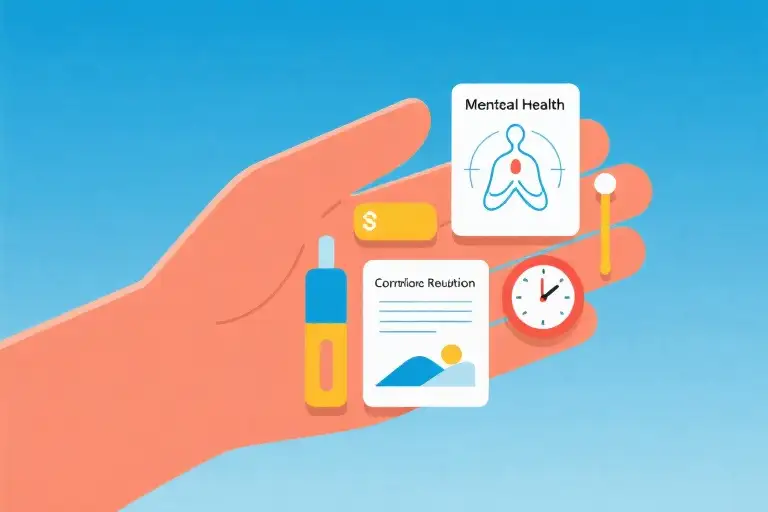You’re sitting at your desk, staring at the computer screen, when suddenly you realize an hour has passed. The report you needed to finish remains untouched, but in your mind, you’ve just lived through an elaborate adventure – complete with dialogue, character development, and plot twists. This isn’t just ordinary daydreaming. When fantasy worlds become more compelling than reality, when you lose chunks of time to intricate mental narratives, you might be experiencing something psychologists call maladaptive daydreaming.
Unlike the brief mental wanderings we all experience, maladaptive daydreaming creates vivid, story-like fantasies that can last for hours. These aren’t just passing thoughts about what you’ll make for dinner or where you might vacation next year. They’re fully realized parallel universes with their own rules, characters, and story arcs. Many people describe it like having a private movie theater in their mind that’s always open, always showing the most captivating films tailored precisely to their subconscious desires.
The troubling part isn’t the daydreaming itself – it’s what happens when these mental escapes start interfering with daily life. Missed deadlines, forgotten appointments, strained relationships. You might notice yourself making subtle facial expressions or gestures that correspond to your inner narrative. Some people pace or rock while daydreaming, completely unaware of their surroundings. The real world fades into background noise as the imagined one takes center stage.
What makes maladaptive daydreaming different from creative imagination or ordinary mind-wandering? Three key elements: intensity, compulsivity, and life disruption. The fantasies feel more real and absorbing than typical daydreams. There’s often a strong, almost addictive urge to return to them. And crucially, they’re causing tangible problems in your work, relationships, or self-care. While creative types might daydream for inspiration, those with maladaptive patterns often wish they could stop but find themselves pulled back in.
If this sounds familiar, you’re not alone – and more importantly, you’re not broken. Many bright, creative people struggle with this pattern. The good news? Understanding what’s happening is the first step toward change. In the following sections, we’ll explore why this happens and how to gently regain control of your attention, without losing the creative benefits of your rich inner world.
Maladaptive Daydreaming: When Fantasy Becomes a Problem
We all daydream – about that vacation we’ve been planning, conversations we wish we’d had, or imaginary scenarios where we’re the hero. But when these mental escapes start feeling more real than your actual life, when you catch yourself missing deadlines because you’ve spent hours lost in an elaborate fantasy, it might be more than just harmless imagination. This is where ordinary daydreaming crosses into maladaptive daydreaming territory.
Maladaptive daydreaming isn’t simply getting distracted. It’s a complex mental state where vivid, narrative-driven fantasies become so absorbing they interfere with daily functioning. Unlike normal daydreams that come and go, these fantasies often have recurring characters, detailed plots, and even their own rules and logic. They’re not just passing thoughts – they’re immersive experiences that can last for hours.
The Telltale Signs
Six key characteristics distinguish maladaptive daydreaming from its normal counterpart:
- Cinematic intensity: The daydreams aren’t vague imaginings – they’re vivid mental movies with clear visuals, dialogue, and emotional arcs. Many describe them as more engaging than real life.
- Time distortion: What feels like minutes in a daydream often turns out to be hours in reality. Meals get skipped, appointments missed, and work neglected as time slips away.
- Physical manifestations: You might find yourself pacing, rocking, making facial expressions, or even whispering dialogue without realizing it. These repetitive motions often accompany the fantasy.
- Emotional dependency: There’s a compulsive quality – you might feel restless or anxious when unable to daydream, using it to regulate difficult emotions.
- Story continuation: Unlike random daydreams, these fantasies often continue across sessions, with complex narratives that develop over weeks or months.
- Real-life interference: The most crucial difference – these daydreams aren’t just distracting, they’re disruptive to work, relationships, and self-care.
Is This You?
Ask yourself these questions:
- Do I regularly lose track of time while daydreaming?
- Do I feel distressed when interrupted from a daydream?
- Have others commented on my ‘zoning out’ or unusual movements?
- Do I prefer my fantasy world to real-life interactions?
- Have my daydreams caused problems at work, school, or in relationships?
If several of these resonate, you might be experiencing maladaptive daydreaming. The good news? Recognizing it is the first step toward change. While these fantasies may have served as a coping mechanism at some point, understanding their impact allows you to reclaim control – not by eliminating imagination, but by restoring balance between your rich inner world and the one waiting outside your mind.
Why Can’t I Stop? The Hidden Mechanics of Maladaptive Daydreaming
The compulsion to retreat into elaborate daydreams often feels like being trapped in a private cinema where the reel never ends. Unlike casual mind-wandering, maladaptive daydreaming operates on deeper psychological mechanisms that demand understanding before change can begin.
Trauma’s Shadow Theater
For many, these vivid mental escapades originate as survival tactics. Childhood abuse survivors frequently report constructing intricate fantasy worlds where they wield control—a stark contrast to their real-life powerlessness. The brain cleverly repurposes daydreaming as a psychological bunker, offering temporary shelter from unresolved pain. This explains why triggering events (an argument, stress at work) can send sufferers scrambling back to their imagined sanctuaries. The fantasies aren’t mere distractions; they’re neurological safe rooms furnished by trauma.
Anxiety’s Misdirection Play
When reality becomes overwhelming, the mind sometimes chooses fantasy as its pressure valve. Socially anxious individuals might rehearse flawless conversations through daydreams, while perfectionists create scenarios where they never fail. The cruel irony? This mental rerouting often exacerbates the very anxiety it attempts to soothe. Like scratching a poison ivy rash, the temporary relief perpetuates the cycle. Notice if your daydreams frequently feature idealized versions of yourself—this grandiosity often masks underlying insecurities.
The Brain’s Reward Trickery
Emerging research points to dopamine dysregulation in compulsive daydreamers. Each fantasy spike delivers a neurochemical payoff similar to scrolling social media or snacking—quick satisfaction with diminishing returns. The basal ganglia, the brain’s habit-forming center, begins treating daydreaming sessions like necessary rituals. This explains the physical restlessness many experience when resisting the urge; it’s not just psychological but physiological addiction in action.
Three patterns emerge across these causes:
- Escapism outweighs recreation (daydreaming as necessity rather than leisure)
- Emotional hangovers follow sessions (guilt, disorientation, or intensified loneliness)
- Time distortion occurs (“I only meant to daydream for five minutes” becomes hours)
Recognizing these mechanisms isn’t about assigning blame, but mapping exits from the labyrinth. When we understand that maladaptive daydreaming is the mind’s flawed solution to real problems, we can start developing healthier alternatives—which is exactly where we’ll turn next.
Immediate Relief: 5 Self-Help Techniques That Work
When maladaptive daydreaming hijacks your afternoon for the third time this week, what you need aren’t abstract theories—you need tools that work right now. These five techniques don’t require special training or expensive resources, just your willingness to interrupt the daydreaming cycle at its weakest points.
The Trigger Journal Method
Carry a small notebook (or use your phone’s notes app) like a detective collecting clues about a mystery. Every time you catch yourself slipping into an elaborate daydream, jot down three things:
- What just happened before the daydream started (a stressful email? boredom during your commute?)
- Any physical sensations you noticed (tension in your shoulders? a sudden urge to pace?)
- The emotional flavor of the fantasy (heroic rescue? romantic idealization?)
After a week, patterns emerge. You might discover that 4pm meetings always trigger escape fantasies, or that certain songs transport you instantly. This isn’t about judgment—it’s about mapping your daydreaming terrain so you can navigate it better.
The 2-Minute Sensory Anchor
When you feel the familiar pull toward fantasy, try this grounding sequence:
- Press your feet firmly into the floor
- Name five colors you can see right now
- Identify four distinct sounds around you
- Touch three different textures (your jeans’ fabric, the cool phone screen, your own knuckles)
- Inhale deeply through your nose, noticing any smells
- Take one slow sip of water, focusing on its temperature and taste
This isn’t about stopping daydreams permanently—it’s about creating a six-step pause button. Many find that after completing the sequence, the compulsion’s intensity drops enough to choose whether to continue daydreaming or redirect attention.
Environmental Resets
Your surroundings whisper cues to your brain without you realizing. Try these subtle tweaks:
- If you usually daydream while lying on your bed, start sitting upright in a chair for all daytime activities
- Change your phone’s wallpaper from fantasy art to a minimalist design
- Rearrange furniture to disrupt habitual daydreaming spots
- Use different lighting during work hours versus relaxation time
These aren’t punishments for daydreaming—they’re gentle reminders to your subconscious that different mental states belong in different physical contexts.
The Replacement Ritual
Maladaptive daydreaming often fills an emotional need. Identify what your fantasies provide (comfort? excitement? control?) and create a 5-minute real-world alternative:
- If your daydreams offer adventure: Try a new walking route with intentional observation
- If they provide connection: Send a genuine compliment to a friend
- If they give escape: Use a meditation app’s brief guided visualization
The key isn’t to eliminate daydreaming completely, but to dilute its monopoly on meeting your psychological needs.
Scheduled Daydream Sessions
Paradoxically, giving structured permission can reduce compulsive urges. Set a timer for 15 minutes daily (same time, same place) for intentional daydreaming. When fantasies intrude at other times, tell yourself: “I’ll explore this during my scheduled session.” Many find that fantasies lose their urgency when they’re no longer forbidden fruit.
What makes these techniques different from generic advice? They acknowledge two truths about maladaptive daydreaming: it serves a purpose in your emotional ecosystem, and willpower alone won’t stop it. By addressing both the triggers and the underlying needs, you create sustainable change rather than temporary suppression.
Rebuilding Healthy Thought Patterns for Long-Term Management
Maladaptive daydreaming doesn’t resolve overnight, but with consistent practice, you can rewire your brain’s default pathways. The journey toward sustainable change involves addressing thought patterns, social behaviors, and physiological factors that contribute to excessive fantasy.
Cognitive Behavioral Techniques That Actually Work
Thought records become powerful tools when used systematically. Start by catching daydream-triggering thoughts in real time – those moments when your mind begins slipping into elaborate narratives. Jot down:
- The triggering situation (e.g., receiving criticism at work)
- The automatic fantasy that follows (e.g., imagining becoming famous to prove critics wrong)
- The emotional payoff (e.g., temporary relief from shame)
Then challenge these patterns by asking:
“Does this fantasy help me solve the real problem?”
“What healthier coping mechanism could I use instead?”
Many discover their most persistent daydreams serve as emotional bandaids. One therapy client realized her intricate romantic fantasies always emerged after feeling ignored – the daydreams provided instant validation her real relationships couldn’t guarantee. Through CBT, she learned to tolerate momentary loneliness while building authentic connections.
The Social Replacement Strategy
Fantasy relationships often fill gaps in real-world interactions. Begin mapping which social needs your daydreams fulfill:
- Companionship? Try scheduling regular coffee dates
- Admiration? Join a hobby group where you can share skills
- Emotional safety? Practice vulnerability with trusted friends
Start small – text a friend instead of retreating into fantasy during lunch breaks. Notice how real interactions, though sometimes messy, provide nourishment daydreams can’t replicate. The key lies in tolerating initial discomfort; many find social muscles atrophy after years of fantasy reliance.
Sleep’s Surprising Role in Daydream Regulation
REM sleep and maladaptive daydreaming share neurological pathways. Poor sleep hygiene leads to:
- Increased mind-wandering during waking hours
- Blurrier boundaries between fantasy and reality
- Stronger compulsive urges to daydream
Improving sleep architecture helps reset these patterns:
- Establish a digital sunset – no screens 90 minutes before bed
- Keep a consistent wake time, even on weekends
- Try magnesium supplements or tart cherry juice for deeper sleep
One university student found his 4-hour daily daydreaming episodes reduced by 60% after fixing chronic sleep deprivation. His fantasy worlds lost their addictive grip once his brain received proper rest.
Maintaining Progress Beyond Initial Success
Relapses happen – a stressful week might trigger old patterns. Instead of self-criticism:
- View slips as data points, not failures
- Re-examine your trigger journal for new patterns
- Return to foundational CBT tools
Consider creating a “recovery kit” with:
- Your most effective grounding techniques
- Encouraging notes from better periods
- Contact info for support allies
True change resembles forest regrowth after a fire – gradual, uneven, but ultimately resilient when the roots establish properly. Each day you choose reality over fantasy, you strengthen neural pathways that will eventually become your mind’s new default setting.
Professional Intervention Guide: When and How to Seek Help
There comes a point when self-help strategies hit their limits. When maladaptive daydreaming persistently disrupts your ability to work, maintain relationships, or care for yourself, professional support becomes not just helpful but necessary. This isn’t about weakness—it’s about equipping yourself with the right tools for a challenge that’s outgrown DIY solutions.
Finding the Right Therapist: 3 Essential Questions
Not all mental health professionals are equally familiar with maladaptive daydreaming. When interviewing potential therapists, these questions can help identify the best fit:
- “What’s your experience with dissociation or compulsive fantasy behaviors?”
- Look for clinicians familiar with related conditions like OCD or PTSD, as the treatment approaches often overlap. Avoid those who dismiss your concerns as “just imagination.”
- “Do you incorporate CBT or mindfulness-based techniques?”
Cognitive Behavioral Therapy has shown particular promise for interrupting the daydream-compulsion cycle. A therapist who combines CBT with grounding exercises can offer practical tools alongside deeper exploration. - “How would we measure progress in my case?”
Effective treatment should include concrete benchmarks, whether it’s tracking daydreaming duration with a journal or rating real-world engagement weekly.
Don’t hesitate to schedule introductory calls with multiple providers. The therapeutic relationship itself—feeling heard without judgment—is a powerful healing factor.
Medication Considerations: SSRIs and Beyond
While no drug specifically targets maladaptive daydreaming, some find relief through medications addressing underlying conditions:
- SSRIs (like fluoxetine or sertraline) may help when obsessive thought patterns or anxiety fuel the daydreaming. They work gradually over 4-6 weeks to reduce mental rumination.
- Low-dose stimulants (e.g., for ADHD) sometimes improve focus enough to disrupt compulsive fantasizing, but require careful monitoring for potential misuse.
- Off-label options like naltrexone (used for addiction) show anecdotal promise in reducing the “high” of immersive daydreams.
Important caveats: Medication alone rarely solves maladaptive daydreaming completely. Combining pharmacotherapy with counseling tends to yield the best outcomes. Always consult a psychiatrist (not just a general practitioner) for nuanced medication management.
Building Your Support Network
Professional help extends beyond one-on-one therapy. Consider these resources:
- Specialized support groups: Organizations like the International Consortium for Maladaptive Daydreaming Research maintain directories of virtual meetups where members share coping strategies without shame.
- Creative outlets: Drama therapy or writing groups can redirect your narrative-building impulses into socially rewarding channels.
- Accountability partners: A trusted friend or coach who understands your triggers can gently redirect you during vulnerable moments.
Remember that seeking help isn’t admitting defeat—it’s reclaiming agency. As one recovered daydreamer put it: “Therapy didn’t take away my rich inner world; it gave me the choice to step out of it when real life needed me.”
Taking the First Step Today
Maladaptive daydreaming doesn’t have to control your life forever. Small, consistent actions can create meaningful change over time. The journey begins with simple awareness – noticing when and why your mind drifts into elaborate fantasies.
Start by keeping a brief log of your daydreaming episodes today. Jot down three things each time you catch yourself slipping into fantasy:
- What triggered the daydream (a song, stressful thought, boredom)
- How long it lasted (estimate)
- What real-world activity it interrupted
This basic tracking serves multiple purposes. First, it builds mindfulness – that crucial ability to observe your thoughts without judgment. Second, patterns will emerge. You might discover certain times of day or emotional states make you more vulnerable. One woman realized her daydreaming spiked whenever she scrolled social media, leading her to limit those sessions.
Research suggests most people see noticeable improvement within three months of consistent practice. The key lies in that word – practice. Like training any skill, managing daydreaming works best through gentle repetition rather than perfection. Some days you’ll catch every episode; other days you’ll realize hours vanished into fantasy. Both are part of the process.
You don’t have to navigate this alone. Our online community brings together thousands who understand exactly what you’re experiencing. Members share:
- Creative coping strategies that worked for them
- Encouragement during setbacks
- Therapist-approved resources
- Safe spaces for vulnerable conversations
Consider this your invitation. Whether you join a support group, try one mindfulness technique, or simply acknowledge this pattern in your life – you’ve already taken the most important step. Healing begins when we stop pretending everything’s fine and start facing reality, one imperfect day at a time.





